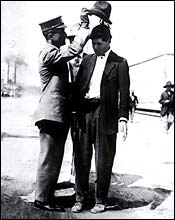
The opening image in Only Skin Deep: Changing Visions of the American Self at the International Center of Photography depicts a starchy group of Navy SEALs, in strict military formation, wearing white uniforms in a white room. They are not smiling, but you know that their teeth are also very white. Everything about them is white. They use Ivory soap. They live in white houses. They drink milk. They dream of a white Christmas. And given half a chance, the photographer implies, they would whitewash the world—no more messy brown, black, red, and yellow people. The photograph, by Vanessa Beecroft, is so damningly white that it telegraphs what kind of show viewers can expect. “Only Skin Deep” will be about racism, the uses of stereotype, historical injustice, and the role of photography in defining the evolving “look” of race in America.
No one who has read about race during the past 25 years or followed the art made on the subject will be surprised by “Only Skin Deep.” The racial attitudes that inform the photographs—from both the present and the past—have been thoroughly explored, and the perspective of the show itself is academic. The images on display are nonetheless disturbing. The camera has been a particularly effective tool for conveying racist ideas, because photographs have a seductive veneer of truth. In the nineteenth century, scientistphotographers, seeking to document all human “types,” created images of tribal peoples that horrify us today because they conceal so much reality behind their putative ethnographic objectivity. During World War II, Life magazine published an article called “How to Tell Japs From the Chinese” that diagrams the physical differences between two Asian men.
Again and again, the camera was regularly used to make large groups of people, especially blacks and Mexicans, appear brutish and animal-like. The usual way of doing this was to juxtapose a white figure of authority, such as a policeman, with a suspect of another race; a picture of master and servant could accomplish the same end. Not surprisingly, contemporary artists have frequently satirized these photographs. On the wall across from the Navy SEALs is a bitterly funny series of photos by Miguel Calderon depicting the scientific “evolution” of a Hispanic male from a down-on-all-fours animal to an upright, gun-toting thug with a messy Afro. In his great photograph Central Park Zoo, New York City, Gary Winogrand shows an elegant mixed-race couple—both the black man and the white woman are very good-looking—carrying a pair of chimpanzees in their arms. Out for a walk with their children?
The curators, Brian Wallis and Coco Fusco, have organized the show around loose thematic pairings, such as “Humanize/Fetishize,” and mixed together historical and contemporary photographs. As a result, the show’s focus is scattered. But the jumble of imagery—and the emphasis on pairing—successfully conveys the varied and paradoxical impulses that underly racial images. The same culture that depicted tribal peoples as animal-like could also use the camera to romanticize them, creating softer but in their way no-less-dehumanizing images. What was Robert Mapplethorpe doing when he idealized the black male nude? Was he perhaps creating another animal, albeit a more beautiful one?
There is an air of bad news in “Only Skin Deep.” America appears mired, intractably, in the issues of race. I’m not sure that’s accurate. The contemporary photographs on display subvert racism; the historical photographs embody it. There’s a difference. As bad as things are today, they are better than they were yesterday. Moreover, American culture no longer seems to yearn for the same shade of white as in the past. More Americans than ever delight in ethnic variety. Where race is concerned, there is always a danger that the good guys—those who oppose racism—will themselves begin to think in old-fashioned, black-and-white terms. For example, that wonderful white-upon-white photograph of the Navy SEALs. Do you suppose that the men are actually the white robotic monsters they appear to be? Or are they being dehumanized too?